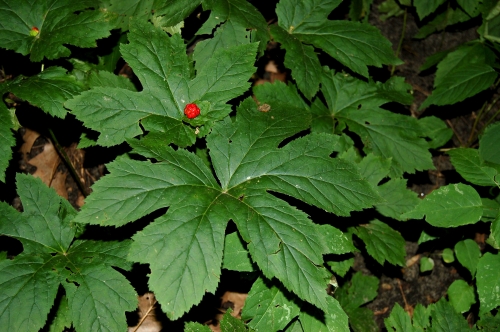Plants and Animals
Hydrastis canadensis Goldenseal
Key Characteristics
Small forb (50 cm) of rich woods; leaves palmately lobed with toothed margins; flowers white with numerous showy stamens; fruit a red berry.
Status and Rank
US Status: No Status/Not Listed
State Status: T - Threatened (legally protected)
Global Rank: G3G4 - Rank is uncertain, ranging from vulnerable to apparently secure
State Rank: S2 - Imperiled
Occurrences
| County | Number of Occurrences | Year Last Observed |
|---|---|---|
| Allegan | 1 | 1976 |
| Barry | 4 | 2012 |
| Berrien | 2 | 1993 |
| Branch | 1 | 1981 |
| Calhoun | 3 | 2006 |
| Cass | 4 | 2022 |
| Clinton | 2 | 1984 |
| Genesee | 1 | 1998 |
| Ingham | 3 | 2021 |
| Ionia | 2 | 1950 |
| Jackson | 5 | 2015 |
| Kalamazoo | 4 | 2020 |
| Kent | 2 | 1989 |
| Lapeer | 3 | 2003 |
| Lenawee | 7 | 2013 |
| Livingston | 3 | 2021 |
| Macomb | 1 | 1991 |
| Monroe | 3 | 2020 |
| Oakland | 9 | 2010 |
| St. Clair | 1 | 2011 |
| St. Joseph | 1 | 1899 |
| Van Buren | 3 | 2006 |
| Washtenaw | 20 | 2018 |
| Wayne | 5 | 2005 |
Information is summarized from MNFI's database of rare species and community occurrences. Data may not reflect true distribution since much of the state has not been thoroughly surveyed.
Habitat
Goldenseal is found in southern hardwood forests, as well as moist ravines and portions of riparian forests.
Natural Community Types
- Dry-mesic southern forest
- Floodplain forest
- Mesic southern forest
- Southern hardwood swamp
- Wet-mesic flatwoods
For each species, lists of natural communities were derived from review of the nearly 6,500 element occurrences in the MNFI database, in addition to herbarium label data for some taxa. In most cases, at least one specimen record exists for each listed natural community. For certain taxa, especially poorly collected or extirpated species of prairie and savanna habitats, natural community lists were derived from inferences from collection sites and habitat preferences in immediately adjacent states (particularly Indiana and Illinois). Natural communities are not listed for those species documented only from altered or ruderal habitats in Michigan, especially for taxa that occur in a variety of habitats outside of the state.
Natural communities are not listed in order of frequency of occurrence, but are rather derived from the full set of natural communities, organized by Ecological Group. In many cases, the general habitat descriptions should provide greater clarity and direction to the surveyor. In future versions of the Rare Species Explorer, we hope to incorporate natural community fidelity ranks for each taxon.
Associated Plants
Basswood, ginseng, trillium, sweet cicely, wild ginger, plantain-leaved sedge, sugar maple, beech, blue-beech, leatherwood, and spicebush.
Management Recommendations
Likely requires maintenance of the overstory and moist, loamy soils and is susceptible to excessive canopy removal. Maintain healthy intact, mature forests and minimize forest fragmentation due to development. When possible, leave large tracts of unharvested forests and allow natural processes to operate unhindered.
Survey Methods
Random meander search covers areas that appear likely to have rare taxa, based on habitat and the judgment of the investigator.
-
Meander search
-
Survey Period: From third week of April to second week of September
-
References
Survey References
- Elzinga, C.L., D.W. Salzer, and J.W. Willoughby. 1998. Measuring and Monitoring Plant Populations. The Nature Conservancy and Bureau of Land Management, Denver. BLM Technical Reference 1730-1. 477pp.
- Goff, G.F., G.A. Dawson, and J.J. Rochow. 1982. Site examination for Threatened and Endangered plant species. Environmental Management 6(4): 307-316
- Nelson, J.R. 1984. Rare Plant Field Survey Guidelines. In: J.P. Smith and R. York. Inventory of rare and endangered vascular plants of California. 3rd Ed. California Native Plant Society, Berkeley. 174pp.
- Nelson, J.R. 1986. Rare Plant Surveys: Techniques For Impact Assessment. Natural Areas Journal 5(3):18-30.
- Nelson, J.R. 1987. Rare Plant Surveys: Techniques for Impact Assessment. In: Conservation and management of rare and endangered plants. Ed. T.S. Elias. California Native Plant Society, Sacramento. 8pp.
Technical References
- Coffin, B. and L. Pfannmuller, eds. 1988. Minnesota's Endangered Flora and Fauna. University of Minnesota Press, Minneapolis. 473pp.
- Flora of North America Editorial Committee. 1997. Flora of North America, North of Mexico. Volume 3: Magnoliophyta: Magnoliidae and Hamamelidae. Oxford University Press, New York. 590pp.
- Gleason, H. A., and A. Cronquist. 1991. Manual of Vascular Plants of Northeastern United States and Adjacent Canada. Second edition. The New York Botanical Garden, Bronx. 910pp.
- Gray, A. 1950. Gray's Manual of Botany; eighth ed. Van Nostrand Reinghold, New York. 1632pp.
- Holmgren, N.H. 1998. Illustrated Companion to Gleason and Cronquist's Manual. Illustrations of the vascular plants of Northeastern United States and adjacent Canada. New York Botanical Garden, Bronx. 937pp.
- Mohlenbrock, R.H. 1986. Guide to the Vascular Flora of Illinois. Southern Illinois University Press, Carbondale. 507pp.
- Scoggan, H.J. 1978. The Flora of Canada. National Museum of Natural Science Publications Botany 4: 1711pp.
- Swink, F. and G. Wilhelm. 1994. Plants of the Chicago Region, 4th ed. Indiana Academy of Science, Indianapolis. 921pp.
- Voss, E. G. 1985. Michigan Flora. Part II. Dicots (Saururaceae-Cornaceae). Bulletin of the Cranbrook Institute of Science and University of Michigan Herbarium. 724pp.



